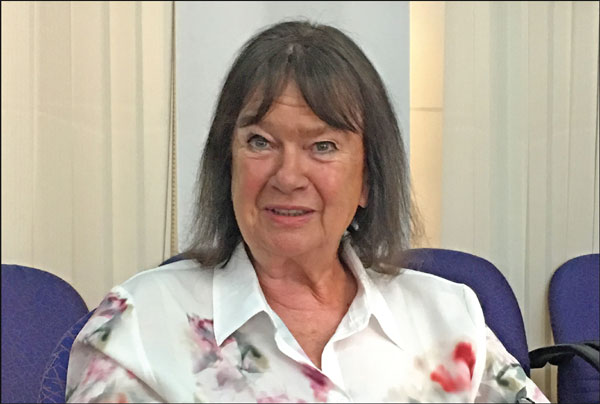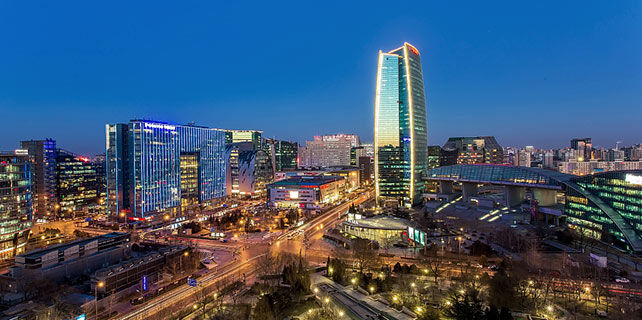Identifying with China
Helga Zepp-LaRouche sees Belt and Road Initiative as fulfilling lifelong pursuit by her and her husband, US political activist Lyndon LaRouche
Helga Zepp-LaRouche was 23 in 1971 when she embarked on a Swedish cargo ship to travel the world. The trip took her to a number of African and Asian countries and included several months in China.
The young German had just finished her training as a journalist. "My generation was still curious about the world. The youth of today, they just Google about things from the search machine. I want to see what the world looks like," she tells China Daily.
China was still in the midst of the "cultural revolution" (1966-76), and as the ship had to be repaired in Shanghai, Zepp-LaRouche had time to observe Chinese society and interact with local people.
|
Helga Zepp-LaRouche speaks to China Daily in an interview. Chen Weihua / China Daily |
She saw gray-painted warships at the mouth of the Yangtze River. She attended organized tours, visited people's homes, factories and a children's palace, and she heard modern Peking Opera played on loudspeakers.
She also met German-speaking Chinese, discussing politics with them and learning what life was like in China at that time. She found that people were kind, but she says, "People were not happy at all."
Zepp-LaRouche also traveled to Qingdao, a seaside city in Shandong province that had a lot of German influence, as well as to Tianjin and Beijing.
In Beijing, she toured places like the Summer Palace and was even tempted to learn Chinese, but she soon realized that it would be difficult and take a long time. "You have to stay here, or you forget it. But anyway, it really started my interest in China," she says.
Zepp-LaRouche, who now travels frequently in China, feels she was fortunate to see China at the time of the "cultural revolution".
Life-changing trip
Of her seafaring in 1971, she says she was shocked by the extreme poverty she saw in Africa. She describes it as "such a shocking experience" and as seeing Africa "from the bottom".
"I came back from this trip with the absolute conviction that the world had to change, had to be improved," she says.
Back in Germany, Zepp-LaRouche tried to look for a theory to fix the problem that haunted her. She found Lyndon LaRouche, a US political activist better known for launching the LaRouche Movement.
The movement, which has included many organizations and companies in the world, promotes a revival of classical art and greater commitment to science; advocates the development of major economic infrastructure projects on a global scale; and calls for reform of the world financial system to encourage investment in the physical economy and suppress financial speculation.
Zepp-LaRouche found LaRouche to be the only one who talked about the need for the development and industrialization of Africa and Third World countries, as well as the establishment of an international development bank, something like the Asian Infrastructure Investment Bank today.
"Then I became part of the movement," she says. On Dec 29, 1977, the two were married in Wiesbaden, a city in west-central Germany.
She says they had been promoting the idea of development of a Eurasian land bridge through infrastructure in the early 1990s, but did not receive a positive response from the United States. "The only government which responded positively was China," she says.

In 1996, she returned to China for the first time to attend and speak at a meeting on Eurasian development. She found a China totally different from the one of 25 years ago. The hundreds of thousands of bicycles on the streets had been replaced by cars.
But she says that comparing 1996 with today, China's development has been more phenomenal. "The Chinese economic model is really the most successful model," she says, adding that China has lifted hundreds of millions of people out of poverty in recent decades.
Since then, she has frequently traveled there, often speaking at think tanks, including the China Institutes of Contemporary International Relations and the Chinese Academy of Social Sciences.
During a trip in 2014 to explore the ancient Silk Road in Northwest China's Gansu province, Zepp-LaRouche was amazed to see the construction of the Lanzhou-Urumqi railroad going at full steam simultaneously in various spots in the desert. The 1,776-kilometer line went into operation at the end of that year.
Belt and Road Initiative
Zepp-LaRouche was excited when President Xi Jinping unveiled the Belt and Road Initiative in 2013. The initiative, which comprises the Silk Road Economic Belt and the 21st Century Maritime Silk Road, is a development concept proposed by Xi to focus on connectivity and cooperation between countries.
She hasn't stopped talking about it since. The Schiller Institute she founded in 1984 also has published significantly on the subject.
In May, Zepp-LaRouche went to Beijing to participate in the Belt and Road Forum for International Cooperation, a meeting that drew 29 heads of state and representatives from more than 100 countries.
"I was really happy to be able to participate because we've been fighting for this for so long. I sort of identify with the success of this project," she says.
Zepp-LaRouche chatted with many people from Africa to Latin America who attended the meeting and found that they shared the same experience. "We were proud to be part of the historical moment of the birth of a new paradigm of mankind.... It was a very strong feeling," she says.
She says she was extremely impressed by Xi's speech, calling it "very rich" and reflecting the ideas of a Confucian philosopher and harmony.
The Schiller Institute also has sponsored conferences in cities across the US, including San Francisco, Detroit and New York, promoting Belt and Road and urging the US to participate.
Unlike the Obama administration, which was more resistant to the Chinese initiatives of the AIIB and Belt and Road, US President Donald Trump has put infrastructure construction atop his agenda and sent an interagency delegation, led by Matthew Pottinger, a National Security Council senior director for East Asia, to the Beijing forum.
Zepp-LaRouche believes that China's financing could help build infrastructure in the US. She says the US needs to build 64,000 kilometers of rail for high-speed trains if it wants to match China's plan to connect every large city by high-speed train by 2020.
"The US economy would experience a tremendous boost through such a grand-scale infrastructural investment and could in turn export into the fast-growing Chinese market, and once competition is replaced by cooperation, the opportunities for joint ventures between the US and China in third countries are enormous," she told a seminar in Beijing in May.
Zepp-LaRouche has repeatedly expressed her admiration for Xi's call that "we have to have a community for a shared future of humanity".
She said in July that the Belt and Road is not just about infrastructure and economic growth, but a new paradigm in which geopolitics is overcome.
Africa development
Zepp-LaRouche is also happy to see growing Chinese investment in Africa.
"If you look at Africa, without Chinese investment, Africa would have no hope. Now people have hope," she says, telling of two Chinese companies that built a 752-km railway linking Ethiopia's capital, Addis Ababa, and the port of Djibouti, where most of landlocked Ethiopia's trade flows.
In late May, Kenya also inaugurated its largest infrastructure project in more than 50 years - a $3.2 billion (2.7 billion euros; £2.5 billion) railway funded by China linking the capital Nairobi with the port of Mombasa.
Zepp-LaRouche was especially excited that China is also helping to build a new railway linking Rwanda, Uganda and Democratic Republic of Congo, a train that she says will go into the heart of Africa "for the first time".
"I have talked with many African diplomats who said for the first time they see the horizon of overcoming poverty and obstacles for development through the help of China," she says.
She says she is disappointed that Europeans talk about human rights and democracy but not development in Africa, and it is the Chinese who have been doing the development work.
A report released in May by Ernst & Young said China has invested in 293 foreign direct investment projects in Africa, with total investment of $66.4 billion, creating 130,750 jobs. Bilateral trade between China and Africa exceeded $137 billion in 2016.
Zepp-LaRouche dismissed the slight by some in the West about Chinese motivation in Africa, citing a seminar she attended in Frankfurt, Germany, when the Ethiopian consul general was asked if China had an "ulterior motive".
"No, because Ethiopia almost has no raw materials," Zepp-LaRouche says the Ethiopian diplomat responded.
chenweihua@chinadailyusa.com
( China Daily European Weekly 08/25/2017 page32)



















